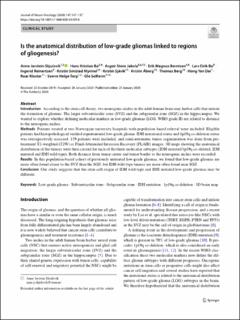| dc.contributor.author | Skjulsvik, Anne Jarstein | |
| dc.contributor.author | Bø, Hans Kristian | |
| dc.contributor.author | Jakola, Asgeir S | |
| dc.contributor.author | Berntsen, Erik Magnus | |
| dc.contributor.author | Bø, Lars Eirik | |
| dc.contributor.author | Reinertsen, Ingerid | |
| dc.contributor.author | Myrmel, Kristin Smistad | |
| dc.contributor.author | Sjåvik, Kristin | |
| dc.contributor.author | Åberg, Kristin | |
| dc.contributor.author | Berg, Thomas | |
| dc.contributor.author | Hong, Yan Dai | |
| dc.contributor.author | Kloster, Roar | |
| dc.contributor.author | Torp, Sverre Helge | |
| dc.contributor.author | Solheim, Ole | |
| dc.date.accessioned | 2021-04-28T06:55:36Z | |
| dc.date.available | 2021-04-28T06:55:36Z | |
| dc.date.created | 2020-08-04T14:59:00Z | |
| dc.date.issued | 2020 | |
| dc.identifier.citation | Journal of Neuro-Oncology. 2020, 147 147-157. | en_US |
| dc.identifier.issn | 0167-594X | |
| dc.identifier.uri | https://hdl.handle.net/11250/2740009 | |
| dc.description.abstract | Introduction According to the stem cell theory, two neurogenic niches in the adult human brain may harbor cells that initiate the formation of gliomas: The larger subventricular zone (SVZ) and the subgranular zone (SGZ) in the hippocampus. We wanted to explore whether defining molecular markers in low-grade gliomas (LGG; WHO grade II) are related to distance to the neurogenic niches. Methods Patients treated at two Norwegian university hospitals with population-based referral were included. Eligible patients had histopathological verified supratentorial low-grade glioma. IDH mutational status and 1p19q co-deletion status was retrospectively assessed. 159 patients were included, and semi-automatic tumor segmentation was done from pre-treatment T2-weighted (T2W) or Fluid-Attenuated Inversion Recovery (FLAIR) images. 3D maps showing the anatomical distribution of the tumors were then created for each of the three molecular subtypes (IDH mutated/1p19q co-deleted, IDH mutated and IDH wild-type). Both distance from tumor center and tumor border to the neurogenic niches were recorded. Results In this population-based cohort of previously untreated low-grade gliomas, we found that low-grade gliomas are more often found closer to the SVZ than the SGZ, but IDH wild-type tumors are more often found near SGZ. Conclusion Our study suggests that the stem cell origin of IDH wild-type and IDH mutated low-grade gliomas may be different. | en_US |
| dc.language.iso | eng | en_US |
| dc.publisher | Springer | en_US |
| dc.rights | Navngivelse 4.0 Internasjonal | * |
| dc.rights.uri | http://creativecommons.org/licenses/by/4.0/deed.no | * |
| dc.title | Is the anatomical distribution of low-grade gliomas linked to regions of gliogenesis? | en_US |
| dc.type | Peer reviewed | en_US |
| dc.type | Journal article | en_US |
| dc.description.version | publishedVersion | en_US |
| dc.source.pagenumber | 147-157 | en_US |
| dc.source.volume | 147 | en_US |
| dc.source.journal | Journal of Neuro-Oncology | en_US |
| dc.identifier.doi | 10.1007/s11060-020-03409-8 | |
| dc.identifier.cristin | 1821616 | |
| cristin.ispublished | true | |
| cristin.fulltext | original | |
| cristin.qualitycode | 1 | |

